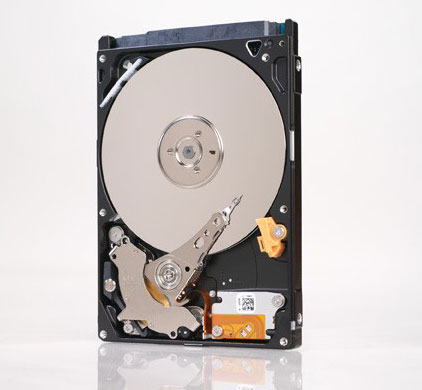Seagate's Momentus XT Reviewed, Finally a Good Hybrid HDD
by Anand Lal Shimpi on May 24, 2010 9:31 AM EST- Posted in
- Storage
- SSDs
- Seagate
- Momentus XT
- Hybrid Drive
- SSHDs
Final Words
Seagate's Momentus XT should become the standard hard drive in any notebook shipped. The biggest problem I have with using any brand new machine, regardless of how fast it is, is that it never feels fast because it usually has a HDD and not an SSD. While the Momentus XT isn't quite as fast as an SSD, it's a significant improvement over the mechanical drives found in notebooks today.
In many cases the Momentus XT performs like a VelociRaptor, but in a lower power, quieter package. The impact of adding just a small amount of SLC NAND is tremendous. I wonder what kept Western Digital from sticking some NAND on its VelociRaptor instead of giving us the lackluster upgrade we got earlier this year.
The potential for hybrid drives continues to be huge, what Seagate has shown here is that with a minimal amount of NAND you can achieve some tremendous performance gains. There's no reason for any performance oriented mechanical drive to ship without at least some small amount of NAND on board. There's also much room for Seagate to innovate. We could see drives with more NAND or truly hybrid drives that provide read and write caching in NAND.

Compared standard 2.5" drives, the Momentus XT will set you back an additional $50 - 90 depending on the capacity point. The added cost is absolutely worth it. It's still a lot cheaper than an SSD since we're in the sub-$0.31 per GB area while SSDs sell in the range of $2 - $4 per GB.
If you're not going to buy an SSD for your notebook, then definitely go for the Momentus XT. I'd almost go as far as to say it's a great option for desktop users but unless you're on a budget you're probably better served by a small SSD + 3.5" drive on the desktop.










120 Comments
View All Comments
Faruk88 - Monday, May 24, 2010 - link
Hey Anand,As always I love your reviews - great job!
I have a quick question: Does this drive constantly spin up and spin down to save power? The reason I ask is because this puts a lot of wear on the mechanical drive.. so I would stay away from this drive if that is the case.
I still wonder why no drive manufacturer has tried to pair 60-80GB of flash with a mechanical drive and combine it into one 2.5" package. Instead of having a hybrid drive like this, I would rather have one Flash partition for my OS and apps, and one partition on the mechanical drive for the rest of my data. This would be useful for laptops, which usually only have one drive bay. Obviously the two "drives" would have to share the SATA bus, but I think the advantages would outweigh the disadvantages.
Faruk
kmmatney - Monday, May 24, 2010 - link
I would also like a system like that. You can also backup for flash partition to the mechanical partition.void2 - Monday, May 24, 2010 - link
Core i3-350M, 5400 RPM 2.5" HDD, clean Windows 7 - and I get ~30 seconds from power button to web browser (~22 seconds if I would install "Boot Cooler", but that's not the point). You, on the other hand, get ~50 seconds on "partial" boot sequence (no POST, no web browser) and much more powerful CPU. It definitely looks like Windows 7 ReadyBoot (successor to "regular" WinXP boot prefetch) did not have enough time to learn. So this does not look like real-life comparison.Drag0nFire - Monday, May 24, 2010 - link
With any notebook HDD, one of the most important considerations for me is how noisy it is. I really value a quiet notebook.Although I know this won't be as quiet as an SSD, could you describe the noise characteristics? Can you hear it at idle? Seeking?
Thanks Anand!
wyemarn - Monday, May 24, 2010 - link
Tom's came up with an article comparing XT with a plain Momentus 7200.4http://www.tomshardware.com/reviews/seagate-moment...
nickkb - Monday, May 24, 2010 - link
The Tom's Hardware review was almost a polar-opposite of Anand's. They performed a number of tests but did not include what I think is absolutely crucial to the intended purpose of this drive: the Boot Time vs. # of runs. I don't know what they intended to extract from all of their tests, as the base storage media of this drive is mechanical, not flash. Therefore, it comes as no surprise that the XT performed almost on-par with the vanilla version of the Momentus 7200.4 in many of their tests.leexgx - Monday, May 24, 2010 - link
most of tomshardware is just junk most of the time and i recommend no one going onto there site as you just end up asking more questionsfboone1 - Monday, May 24, 2010 - link
I'm definitely intrigued by this drive. If I were to put 2 of them in a RAID 0 array, what would happen? Would I have effectively 8GB of NAND cache? Would doing so greatly increase performance?BJ Eagle - Wednesday, May 26, 2010 - link
I for one would certainly alspo like to see RAID 0 and 1 results. I would suspect that this Momentus XT drive would benefit similiar to RAID as traditional harddrives, but it would be nice to have it confirmed.CharonPDX - Monday, May 24, 2010 - link
Since when is a third of a Watt at idle, three-quarters of a Watt at load, "consider[ably] more power"?
With most notebooks nowadays having a 40 Watt-hour batteries or higher, an increase of one Watt won't exactly kill battery life. And that's assuming it's going constantly at full power.